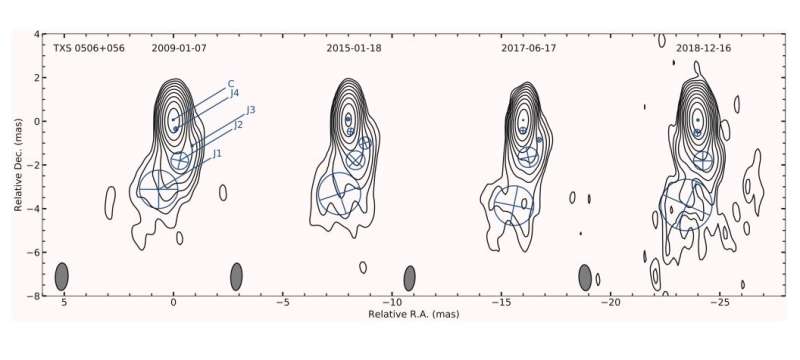Parsec-scale radio structure of TXS 0506+056 at 15 GHz. Credit: Li et al., 2020.
Using the Very Long Baseline Interferometry (VLBI) technique, astronomers have probed the parsec-scale jet of a neutrino-emitting blazar known as TXS 0506+056. Results of the new study, presented May 1 on arXiv.org, shed more light on the properties of this jet, which could improve the understanding of very-high energy (VHE) neutrinos.
Blazars, classified as members of a larger group of active galaxies that host active galactic nuclei (AGN), are powerful sources of emission across the electromagnetic spectrum from radio to very high-energy gamma frequencies. Their characteristic features are relativistic jets pointed almost exactly toward the Earth.
In general, blazars are perceived by astronomers as high-energy engines serving as natural laboratories to study particle acceleration, relativistic plasma processes, magnetic field dynamics and black hole physics. Therefore, high-resolution observations of blazars and their jets in different wavelengths could be essential for improving the understanding of these phenomena.
At a distance of approximately 5.75 billion light years, TXS 0506+056 is a VHE blazar that was detected as a radio source in 1983. It is the first known source of high-energy astrophysical neutrinos. After the detection of a neutrino event designated IceCube-170922A, coincident with the blazar's direction and arrival time during a gamma-ray flare, an intense multi-wavelength monitoring of this object commenced.
Radio VLBI observations have the potential to locate the production sites of neutrinos. So a team of astronomers led by Xiaofeng Li of Shanghai Astronomical Observatory, China, analyzed archival VLBI data regarding TXS 0506+056, focusing on its jet. The study is based on datasets from the VLBI Calibrator Survey (VCS) project, the Monitoring Of Jets in Active galactic nuclei with the Very Long Baseline Array (VLBA) Experiments (MOJAVE) survey archive, and the National Radio Astronomy Observatory (NRAO) data archive.
"The pc-scale jet properties of the neutrino–emitting blazar TXS 0506+056 are explored here using multi-frequency, multi-epoch VLBI data," the paper reads.
The study found that the blazar's jet structure showcases a helical trajectory originating in growing instabilities, with a precessing period of five to six years. The jet is composed of a core and four components designated J1 to J4. The sizes of the jet components increase with the radial distance from the center, hence the outermost component J1 is the most extended with the largest size, and the innermost J4 has the smallest size.
According to the paper, the jet of TXS 0506+056 has an inclination angle of about 20 degrees and a half opening angle of approximately 3.8 degrees. The astronomers noted that the jet's apparent speed and its calculated beaming parameters suggest that it is a moderately relativistic jet.
Furthermore, the jet's magnetic field strength was estimated to be between 0.2 and 0.7 G, decreasing during the recent ongoing flaring period. The researchers added that this points to a conversion of the magnetic field energy density to particle energy density. This process helps accelerate particles upon injection at the jet base, which subsequently produces the flares.
"The neutrino event detected during the rise of the radio flare could then be associated with the onset of particle injection and acceleration which can contain a large portion of the converted energy density. This scenario provides support to a lepto-hadronic origin of the VHE neutrinos and gamma-ray emission owing to a co-spatial origin at the particle injection and acceleration site," the authors of the paper concluded.
More information: The parsec-scale jet of the neutrino-emitting blazar TXS~0506+056, arXiv:2005.00300 [astro-ph.GA] arxiv.org/abs/2005.00300
© 2020 Science X Network























